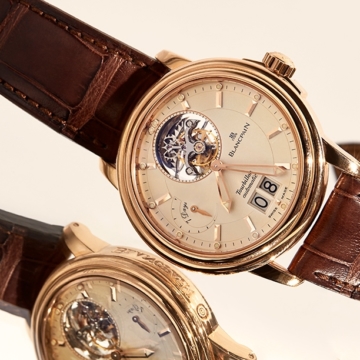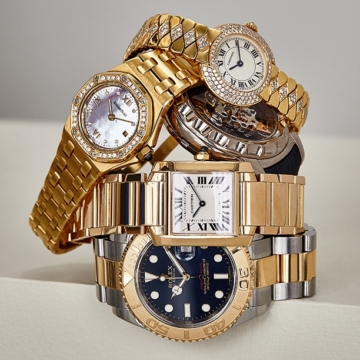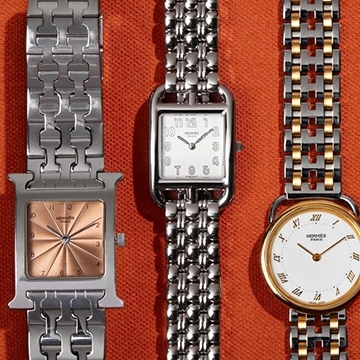

Tourbillons to Tachymeters: the Investment-worthy Details Behind Classic Watches
Classic luxury watches are about more than telling time. Their worth lies in their precision, craftsmanship, brand cachet, elevated design … and horological innovation. Complications (any feature other than the function of telling time) automatically add an extra level of mechanical complexity to a watch, and their inclusion can cause price tags to rise and collectors to take note. But what about their addition is so investment-worthy? Read on as our Senior Watch Valuation Manager Danny Avizov goes over how these features function, how they’ve changed over the years and how they ultimately add value to a fine watch.
The Moonphase Complication

What it does: The moonphase complication on a watch shows the phases of the moon from full to new and back. It’s viewed on a painted or engraved disk through an aperture on the dial, or as a hand in a sub-dial that points to the various phases of the moon.
The earliest use of the moonphase complication: Humans have long been fascinated by the moon and used it to measure time and manage agriculture. The first moonphase complication dates back to an astronomical clock from the 2nd century BCE. One of the oldest working clocks in Europe is an astronomical clock circa 1389 called Le Gros Horloge, located in Rouen, France, and others circa the 16th and 18th centuries can be seen in towns throughout Europe. Moonphase complications next make an appearance on pocket watches. Beautifully painted, enameled or engraved designs would be fitted into watches for the few who could afford such a luxury in their timepiece.
Why it adds value to a fine watch: Today, the complication has been added to both entry-level and luxury timepieces, from quartz to mechanical, so its value lies in the laborious artistry that accompanies many top-tier timepieces. Arnold & Son, which started in the mid-18th century, is one of the few brands to embark on the beautification of the moonphase. Solid gold disks with guilloche patterns overlaid in enamel take up almost the entirety of the dial. This craftsmanship and execution, done almost entirely by hand, offers something that few brands are bold enough to embrace. Jaeger-LeCoultre, A. Lange & Söhne, Patek Philippe and Breguet have all created watches with exquisite moonphase complications.
Fun fact: While pricey watches abound, the Patek Philippe Henry Graves Supercomplication pocket watch takes the cake. Commissioned by American banker Henry Graves Jr. in 1932, the timepiece features 24 complications. It technically doesn’t have a moonphase complication, but instead takes things a step further — the pocket watch features a celestial chart that displays the sky above Graves’ New York estate. In 2014, it went to auction and sold for $24 million, and at the time was the most expensive timepiece in the world.
The Power Reserve Indicator
A. Lange & Söhne Grand Lange 1 Watch
What it does: A power reserve indicator is a watch complication that lets the wearer know the approximate amount of time a mechanical, hand-wound watch will remain running before it needs to be wound again.
The earliest use of the power reserve indicator: Marine chronometers — special clocks used to determine longitude at sea, developed in the 1700s — were some of the first devices to be equipped with power reserve indicators. While Breguet was the first watch brand to develop a wristwatch prototype with a power reserve complication, Jaeger-LeCoultre’s 1951 Futurematic model was the first to be produced for the market. The power reserve indicator can be displayed in any number of ways, from a sub-dial to a straight bar going across the length of a dial to a presentation case back.
Why it adds value to a fine watch: Power reserve indicators are incredibly valuable from a functionality standpoint. It is inherently useful to know when to wind your watch before it stops working, and the complication’s inclusion will of course cause a rise in the watch’s price.
Fun fact: In 2007, A. Lange & Söhne was the first luxury manufacturer to create a mechanical wristwatch with a power reserve lasting 31 days, called the Lange 31. Because it requires such an enormous amount of power to stay functional for more than a month, it includes a single barrel with two mainsprings, each 185 centimeter long. These are more than seven times longer than conventional mainsprings, and because of their length, the watch requires a leverage-wielding key to wind it as opposed to a small crown.
The Tourbillon

What it does: The tourbillon (French for “whirlwind”) is a cage for the balance wheel and hairspring to rotate within that negates the effect of gravity, ensuring more accurate timing.
The earliest use of the tourbillon: Abraham-Louis Breguet was an 18th-to-19th century Swiss watchmaker who spent most of his career in France (King Louis XVI and Marie Antoinette were big fans). During the mid-1790s, Breguet realized that the pocket watches he created spent most of their time in two positions — lying down and resting upright in a pocket. This meant that gravity was weighing down the balance spring and escapement parts, i.e. affecting the watches’ accuracy. By putting the watch’s escapement in a rotating cage, Breguet found a way to negate the effect of gravity. Today, we also see tourbillon escapements that not only rotate within a cage but also spin on an axis, as made by Greubel Forsey.
Why it adds value to a fine watch: Few watchmakers and manufacturers are able to create this complicated escapement, and a timepiece’s value starts soaring with its inclusion. Typically these timepieces will fall within a six-figure range for the resale market, depending on brand cachet, materials used, polishing techniques performed and newfound innovations.
Fun fact: Robert Downey, Jr. was recently spotted wearing a Greubel Forsey Double Tourbillon Technique that goes for a cool $560,000. It features two tourbillons — one inner and one outer — which improve timekeeping by fighting gravity off in all typical wristwatch positions.
The Retrograde Date Complication

Vacheron Constantin Patrimony 31 Day Retrograde Watch
What it does: A retrograde date complication is completely different than a standard digital date complication (showing the numbered day of the month in a small window). “Retrograde” hands on a watch move across a segment of a circle before springing back to their initial position. A retrograde date complication lists the numbers out in a semicircle and the hand sweeps across day by day before returning back to 1 on its own. Retrograde features are most frequently displayed as an arc, which can be located anywhere on the dial.
The earliest use of the retrograde date complication: In the late 17th century, some French pocket watches would display the hour in a retrograde function, moving in an arc as opposed to circling the dial’s perimeter. Abraham-Louis Breguet used this function to create watches with retrograde date and retrograde equation of time complications in the 18th century. Days, dates, hours, minutes and even seconds can now be displayed this way.
Why it adds value to a fine watch: Any kind of retrograde indicator adds visual interest and a novelty factor. These indicators can also be minimized on a dial, providing ample room for additional complications — moonphase, power reserve, et cetera. Its inclusion makes for an intriguing selling point on any top-tier timepiece.
The Chronograph & The Tachymeter
Rolex Cosmograph Daytona Watch






